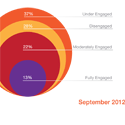
By Don MacPherson
As United States organizations continue operating under the pressure of unstable economic conditions, many strategize that improving employee engagement presents a competitive advantage. When employees are engaged, they feel a deeper connection and commitment to the organization. They’re more likely to perform at optimum levels and put forth discretionary effort that fuels organizational growth. And the business impact of a highly engaged workforce is clear: Many studies link engagement to improved operational performance, customer satisfaction, employee productivity, absenteeism, turnover, and support of the organization’s vision and strategy.
While improving employee engagement may dictate the very survival of some organizations in a poor economy, the lasting benefits of a highly engaged workforce will also contribute toward an organization’s performance and market position when economic conditions become more favorable. The good news for all is that there are clear indicators of an economic recovery on the horizon.
Since 2007, Modern Survey has conducted its biannual report, National Norms Study of Engagement Levels of U.S. Workers. This latest research, conducted in September 2012, compares the responses of 700 adults working full time for organizations with 100 or more employees.
Key Findings
Over the last year, employee engagement in the U.S. workforce has shown significant improvement. The survey found a 5 percentage point increase in the number of fully engaged employees, balanced by an equal drop in the number of under engaged employees compared to 2011.
Having faith in the stability of their current organization and job position may be a reason for this increase in engagement. In recent years, employees’ belief in a promising future within their organization had been falling steadily, from 48 percent in 2010 to a precipitously low 34 percent in 2011 — the lowest that Modern Survey has recorded since it started tracking the engagement of U.S. workers in 2007. Over the last year, however, this critical measure of engagement has recovered to 41 percent. Indeed, employees’ belief in a promising future is the only component of Modern Survey’s five-item Engagement Index that improved enough over the last year to represent a statistically reliable change.
According to a recent Gallup poll, for the first time in five years more Americans are feeling better off financially than they did a year ago, as opposed to worse off. These results are entirely consistent with how respondents feel their companies are doing today compared with a year ago. It seems that increasing optimism about personal futures is being fueled by improvements in the economy in general, and the employees’ sense that their organizations are improving in step with the nation’s economic recovery.
Consistent with our past national norms studies, the latest findings confirm that employees’ confidence in the future prospects of their company continues to be a leading driver of engagement. However, the 2012 National Norms Study now places employees’ confidence in the organization’s senior management as the most influential and impactful driver of overall engagement.
Confidence in leadership remains stagnant holding steady at 41 percent for 2012 and 2011. In the context of a lengthy recession, the actions of senior leaders have become extremely powerful drivers of employee engagement. Despite this fact, any newfound employee optimism about their personal future doesn’t appear to be attributable to the intentions or capabilities of senior leaders.
It’s likely that employees’ growing confidence in the future of their organizations is attributable to an improving climate of U.S. economic, political, demographic or social influences. As organizations continue operating under the constraints of a recovering economy, senior leaders have both an opportunity and a responsibility to improve communications with employees that focus on the vision, goals and performance of the organization. Truthful and consistent messaging from senior leaders will go a long way toward improving the levels of trust, respect and engagement of their workforce.
Improved performance also boosts engagement. The survey found a strong correlation between how employees view their organization’s business performance and their levels of personal engagement. To better gauge this association, a new question was included:
Overall, my organization is doing better now than it was a year ago. The results from this question were quite positive with 45 percent of respondents agreeing that performance within their organization has improved. Further, these same employees have a strong belief that their company is heading in the right direction (80 percent), they have confidence in their company’s future (85 percent), and perhaps most important, from an employee retention perspective, they believe that they have a promising future at their company (61 percent). In support of the assumption that organizational performance is directly attributable to employee engagement, we also found the converse to be true; of the 1 in 5 employees who disagreed with this new question, more than half of those same employees are considered disengaged.
The study results also suggest that compensation is becoming an increasingly potent driver of employee disengagement among U.S. workers. It appears that employees are more dissatisfied with their total compensation than at any time in recent history. The number of employees rating their total compensation as favorable (51 percent) is the lowest we have seen since August 2010, while the number of employees rating their total compensation as unfavorable has continued a steady climb over the past two years.
On closer examination, we discover that fair and competitive pay is considered table stakes for today’s workers. In other words, while strong dissatisfaction with compensation can be directly linked to higher disengagement, a strong satisfaction with compensation does not, conversely, translate to higher engagement. It appears that the lynchpin for creating and sustaining engagement through compensation requires consistency, fairness and equity in an organization’s compensation practices.
Don MacPherson is president and co-founder of the human capital measurement company, Modern Survey.














